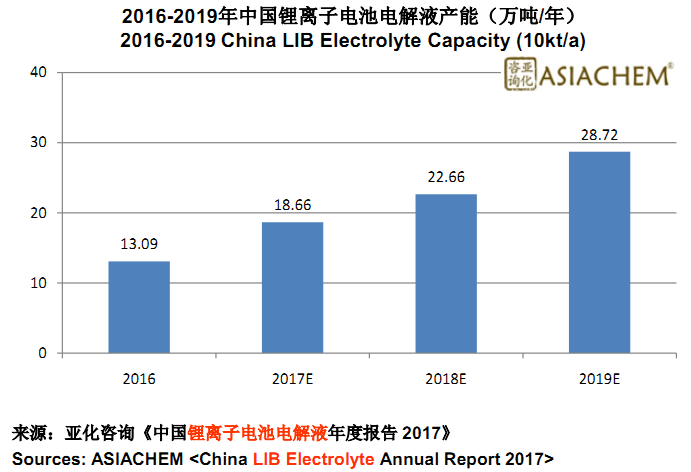Electrolyte, as one of four key materials of LIB, plays an important role on cycle life, safety and capacity play of LIB. Before, influenced by China electrolyte enterprise technology far behind, under capacity etc. factors, abroad electrolyte tycoons ‘dig for gold’ in China one after another. However, public information shows that, electrolyte factories of Germany BSF and Japan UBE in China had huge loss. ASIACHEM ‘China LIB Electrolyte Annual Report 2017’ shows that, operating conditions of those foreign electrolyte manufacturers in China are as below.
BASF USD 1 Sold in China’s Electrolyte Business
In May, 2017, Capchem signed agreement with BASF Investment and BASF (China). According to the agreement, Capchem would use self capital to purchase 100% share of BASF Battery Material which was held by BASF Investment and BASF China and transaction consideration was USD 1. Meanwhile, Capchem provided BASF Battery Material Co. needs to return to BASF and associated companies of BASF a total of CNY 213M’s debt a guaranty.
Audit report issued by KPMG shows that, revenue of BASF Battery Material Suzhou Co. in 2016 was CNY 167M, and net profit was CNY -170M; from Jan to Mar, 2017, revenue was CNY 28.8814M and net profit was CNY -7.6802M.
Mitsubishi Chemical and Ube Industries Announced to Combine Electrolyte Business in China
In Oct, 2016, Mitsubishi Chemical and Ube Industries announced to combine both parties in China’s electrolyte business. Meanwhile, both parties will set up a 50-50 share’s joint venture company, share patents to develop new products. What is more, both parties are considering combining businesses in US and Europe.
Ube Industries Annual Report shows that, up to Mar 31, 2016, the company locates in Zhangjiagang, China’s AET Electrolyte Technologies LLC loss was JPY 27.59M (about CNY 170M)
Formosa Mitsui Electrolyte Business Progress is Slow
At the end of 2012, Formosa Plastic Group and Japan Mitsui Chemicals joint venture and set Formosa Mitsui Precision Chemical Co. in China and planned electrolyte capacity was 5000t/a.
News reported in Apr 2016, Formosa Mitsui Precision Chemical Co. electrolyte project Phase-1 1500t/a project entered trial production stage and about to operation soon. The progress was very slow.
Tianjin Panax Etec Plans to Expand Electrolyte Capacity
In 2008, South Korea PANAX ETEC set up Tianjin Panax Etec, an electrolyte subsidiary in Tianjin, China and annual produce 2400t electrolyte. To meet market requirement, in Jun, 2017, Tianjin Panax Etec released EIA (first time), stated that its electrolyte would be increased to 12000t/a.
Why most foreign/JV electrolyte manufacturers in China currently retreating from China? ASIACHEM believes that, the reasons are mainly as below.
1) Domestic electrolyte enterprise companies competitiveness increases
China LIB enterprises (e.g. BYD, Tianjin Lishen etc.) in early stage completely relied on imported electrolyte. Disadvantages of expensive price and long delivery time etc. were not benefit for development of LIB industry. From 2001, domestic made electrolyte started to enter the market, electrolyte selling price went down, and started to gradually realize import substitution, and competitiveness increases.
With technology accumulation and improvement in recent years, some domestic enterprises gradually start to supply electrolyte to international market and those Japanese and South Korean LIB manufacturers in China.
Through continuous efforts, Capchem makes a major breakthrough in South Korean and other Southeastern Asian markets and successfully enters LG Chem supply system, and becomes excellent supplier of Samsung and Sony.
2) China Electrolyte Has Overcapacity
ASIACHEM ‘China LIB Electrolyte Annual Report 2017’ shows that, in 2016, China electrolyte capacity has reached 130.9kt/a. However, China electrolyte consumption in the same year was 72.4kt; overcapacity is significantly. To 2019, China electrolyte capacity will reach 287.2kt/a.

3) Widely Fluctuate of Lithium Salts Price Influences Electrolyte Enterprises Profit Space
Electrolyte is mainly made of electrolyte lithium salt, solvent and additive. Currently, LiPF6 is the lithium salt that is mainly used. Its cost occupies quite large proportion of electrolyte cost, and its price’s widely fluctuated influences profit space of electrolyte enterprises. ASIACHEM ‘China LIB Electrolyte Annual Report 2017’ believes that, enterprises can ensure lithium salts reasonable price’s supply via self produce LiPF6 or maintain long term good cooperation with China and abroad suppliers, so that high gross profit rate can be maintained. On this aspect, China electrolyte leading enterprises have made very good examples.
1) Tinci Materials
In Jul, 2017, Tinci Materials stated that, the company 6000t/a liquid LiPF6 product has put into operation, currently it is under capacity releasing stage; 2000t/a solid LiPF6 project is under construction and estimated to finish by the end of this year.
2) Capchem
In May, 2016, Capchem stated that, on purchase of LiPF6, the company maintained long term good cooperation with China and abroad suppliers and can guarantee sufficient supply. In hence, the company did not have plan to produce LiPF6.
ASIACHEM ‘China LIB Electrolyte Annual Report 2017’ believes that, except continue R&D on technologies, abroad/JV enterprises can also layout capacity surrounds large size LIB enterprises. Strengthen cooperation with clients and relationship’s binding are also best ways to against risk of future market. Example is as below.
In Apr, 2017, Jiangsu Guotai released announcement, Zhangjiagang Guotai Huarong Chemical New Material Co. Ltd., holding subsidiary of the company, planned to set up wholly owned subsidiary Ningde Guotai Huarong New Material Co. Ltd. in Ningde, Fujian. It planned to rent factories of CATL in Ningde, total invest about CNY 100M, to implement 40kt/a power LIB electrolyte project. The project estimated construction period is 1 year.